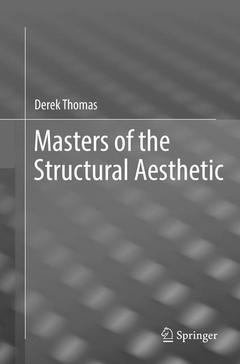Description
Masters of the Structural Aesthetic, Softcover reprint of the original 1st ed. 2018
Author: Thomas Derek
Language: English
Subjects for Masters of the Structural Aesthetic:
Publication date: 02-2019
Support: Print on demand
Publication date: 09-2017
Support: Print on demand
Description
/li>Contents
/li>Biography
/li>Comment
/li>
This book highlights aesthetics as pertaining to the structural component in architectural design. This less explored aspect of architecture is discussed and explains the enduring qualities of ten specific buildings from architectural history to present day due to their structural aesthetics. Based on comprehensive research, a critical analysis is presented of the constraints and other influences on architectural and structural design, such as culture, patronage, geometry, available resources and technologies.
INTRODUCTION: Identifying ‘Masters of the structural aesthetics’
CHAPTER ONE: Elemental determinants
Aesthetic Theories & Symbolism
Context
Patronage and Ethics
Religion and Secular practice
Materials and Resources
Biomimesis & Biomimicry (Nature)
Fractal Geometry
Thematic transformation
Generative algorithms
Parametricism
Exoskeletonism
CHAPTER TWO: Ten Masters and their architectural legacies
Roman builders (2BCE – 4CE): The Rotunda, Rome
Gothic architects (13 – 15CE): Chartres Cathedral, France
Filippo Brunelleschi (1377– 1446): St Maria, Florence, Italy
Antoni Gaudi (1852 – 1926): Church of La Sagrada Familia, Barcelona
Le Corbusier (1887-1965): Chapel of Notre Dame du Haut, Ronchamp, France
Pier Luigi Nervi (1891-1979): Exhibition Hall, Turin
Oscar Niemeyer (1907-2012): University of Constantine, Algeria
Jörn Utzon (1918-2008): Opera House, Sydney
Frei Otto (1925-2015): Olympic Stadium 1972 , Munich, Germany
Zaha Hadid (1950-2016): Heydar Aliyev Centre, Baku, Azerbaijani
CHAPTER THREE: Comparative Case Study
The technologies and the structural aesthetics employed by Fillipo Brunelleschi (Renaissance) and Pier Luigi Nervi (Modern).
FUTURE PARADIGMS:
The Avantgarde, Artificial Intelligence, New technologies inter alia.
Derek’s career has been in architectural practice for forty years coupled with engagement with the academic environment at university level – specifically in third and final year architectural studies and environmental science (MA). This experience has provided insights into what attributes constitute the best in architectural design, and with travel has provided me with an overview of architectural examples that are iconic and highly acclaimed. He is a published author of books on architecture (Architectural Press, 2002) and urban design (Routledge, 2016).
Encapsulates the essence of aesthetics in terms of structure of ten recognised landmark buildings from architectural history to present day
Explores the potential of structure that is generally not focussed on in architectural studies or practice
Comprehensive referencing, supporting the choice of the ten subjects presented and illustrated with historical pictures/photographs

